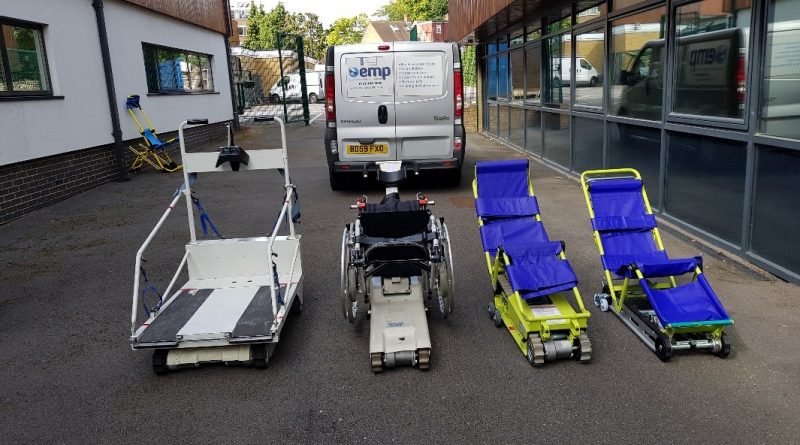The world of assisted access and egress devices, such as evacuation chairs, is becoming a crowded and confusing market, so how do you choose your supplier?
The world of assisted access and egress devices, such as evacuation chairs, is becoming a crowded and confusing market, so how do you choose your supplier?
Do you choose a company you have always dealt with, irrespective of whether or not they offer you various options, not just their own equipment. Or do they explain that more suitable models are available and would be better for you?
Evaccess (formerly Swallow EMP) have, since setting up in 2008, offered a comprehensive range of products to suit all needs. We have never understood why clients are not always made aware the best models for their employees, visitors, clients, students etc.
We offer chairs from a number of manufacturers (Antano, Bartels, Escape Mobility, AAT, to name a few) so that there are a choice of models for clients to choose from and this way you are offered from a range not just what we manufacture.
Since their introduction in approx. 1979 the Sunwa range of evacuation chairs and stair climbers have been designed with the needs of disabled people (PRM) as key to the design, which is why there are models to take people in both manual and powered wheelchairs as well as models where a person can transfer.
One range that we offer – Left to right; takes manual and powered wheelchair users (powered), manual wheelchair users (powered), for people who can transfer (powered) and a manual version (downward only and is a braked unit).
If you have a particular person who requires assistance, then a Personal Emergency Evacuation Plan (PEEPs) must be completed, and the correct equipment purchased.
Why would you purchase a ‘standard evac chair’ for a person in a powered wheelchair, that cannot be used by the person who needs it!
It is your responsibility to get people to a place of safety (not a refuge area), not that of the Fire Service.
2021 – Where are we now
Disabled people are being advised by the Equality & Human Rights Commission (EHRC) that they can make a formal equality complaint under the Equality Act 2010 and the Human Rights Act 1998 for failure to provide an auxiliary aid or service such as an assisted escape device. The EHRC have also provided a template letter that can be used in the process.
It is essential that building managers, managing agents and fire risk assessors are also aware that there is now no published fire safety guidance that fails to advise that personal emergency evacuation plans (PEEPs) must be provided for disabled people.
An article by Inside Housing on 21st April stated that the “LGA had decided to remove the Fire Safety in Purpose-built Flats last week following the British Standards Institution’s (BSI) withdrawal of new guidance on fire risk assessments last month amid a legal challenge from families bereaved by the Grenfell disaster. Both the 2011 guidance and the new BSI guidance had suggested that personal emergency evacuation plans (PEEPs) for residents with disabilities are not usually necessary. This contradicts a recommendation from the Grenfell Tower Inquiry’s phase one report that ‘the owner and manager of every residential high-rise be legally required to prepare personal emergency evacuation plans for all residents whose ability to self-evacuate may be compromised’.
Questions
Is there a chair / device to take a person in their manual or powered wheelchair up and down stairs, up to 230kg?
Are there models to move someone in a manual wheelchair up and down stairs?
Is there equipment to take people up and down stairs, where the person can transfer and go on their way without a wheelchair after an evacuation?
Do you require kit designed to be used safely on spiral and flared stairs?
Is there a manual downward evacuation chair with a dead mans handle that means that the descent is always controlled and not dictated by operator strength?
Are there manual evacuation chairs that require less training time as it is easy to use safely?
The answer from Evaccess is a definitive YES.
Are your current suppliers advising you of this? Other companies can purchase from us as we believe and always have believed that the most important reason why you choose an evacuation chair is for the person who needs it, not just to get a sale.
Most people associate evacuation chairs with the friction belt type, just as Hoover was with vacuum cleaners. Companies who until recently only offered manual chairs, irrespective of a clients’ needs, are now looking for powered versions. This is because they have eventually realised that power reduces the handling and fatigue caused by using a manual chair in multi story / tall buildings.
Training
How many people in your organisation are trained to operate the chairs?
How many can still operate the kit, given there may have been months of inactivity.?
Are those people going to be on site at all times the building is open?
Are your chairs easy to operate by one person and can additional operators be trained in a timely manner to ensure you have cover?
Some chairs are easier to operate than others and therefore choose a chair that works for your business and colleagues. You will find it easier to source more volunteers/ operators if the chair is simple to operate and does not rely on their physical strength. Cheaper units do not give you this and could cost you more in the long run.
Service
Ensure your chairs are serviced annually.
All units should be part of your monthly/quarterly inspections and visually checked
Powered units – set up monthly checks to check the units are fully charged. Batteries last longer if they are used.
Call Evaccess for more information on the choice of chairs for your people, stairs, landings, training and servicing.

